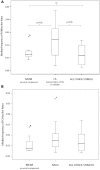Ultrasonographic Investigation of Human Fetus Responses to Maternal Communicative and Non-communicative Stimuli
- PMID: 27014160
- PMCID: PMC4792883
- DOI: 10.3389/fpsyg.2016.00354
Ultrasonographic Investigation of Human Fetus Responses to Maternal Communicative and Non-communicative Stimuli
Abstract
During pregnancy fetuses are responsive to the external environment, specifically to maternal stimulation. During this period, brain circuits develop to prepare neonates to respond appropriately. The detailed behavioral analysis of fetus' mouth movements in response to mothers' speech may reveal important aspects of their sensorimotor and affective skills; however, to date, no studies have investigated this response. Given that newborns at birth are capable of responding with matched behaviors to the social signals emitted by the caregiver, we hypothesize that such precocious responses could emerge in the prenatal period by exploiting infants' sensitivity to their mother's voice. By means of a two-dimensional (2D) ultrasonography, we assessed whether fetuses at 25 weeks of gestation, showed a congruent mouthmotor response to maternal acoustic stimulation. Mothers were asked to provide different stimuli, each characterized by a different acoustic output (e.g., chewing, yawning, nursery rhymes, etc.) and we recorded the behavioral responses of 29 fetuses. We found that, when mothers sang the syllable LA in a nursery rhyme, fetuses significantly increased mouth openings. Other stimuli provided by the mother did not produce other significant changes in fetus' behavior. This finding suggests that fetuses are sensitive only to specific maternal vocalizations (LA) and that fetal matched responses are rudimentary signs of early mirroring behaviors that become functional in the postnatal period. In conclusion, fetuses seem to be predisposed to respond selectively to specific maternal stimuli. We propose that such responses may play a role in the development of behavioral and emotional attunement with their mothers long before birth.
Keywords: acoustic-visual integration; matching system; mother communication; mouth movements; voice.
Figures




Similar articles
-
Memory Traces Formed in Utero-Newborns' Autonomic and Neuronal Responses to Prenatal Stimuli and the Maternal Voice.Brain Sci. 2020 Nov 11;10(11):837. doi: 10.3390/brainsci10110837. Brain Sci. 2020. PMID: 33187287 Free PMC article.
-
Fetal Behavioural Responses to Maternal Voice and Touch.PLoS One. 2015 Jun 8;10(6):e0129118. doi: 10.1371/journal.pone.0129118. eCollection 2015. PLoS One. 2015. PMID: 26053388 Free PMC article.
-
Audiological evaluation of infants using mother's voice.Int J Pediatr Otorhinolaryngol. 2019 Jun;121:81-87. doi: 10.1016/j.ijporl.2019.03.005. Epub 2019 Mar 11. Int J Pediatr Otorhinolaryngol. 2019. PMID: 30877980
-
Fetuses respond to father's voice but prefer mother's voice after birth.Dev Psychobiol. 2014 Jan;56(1):1-11. doi: 10.1002/dev.21084. Epub 2013 Jul 2. Dev Psychobiol. 2014. PMID: 23817883
-
Fetal face as important indicator of fetal brain function.J Perinat Med. 2017 Aug 28;45(6):729-736. doi: 10.1515/jpm-2016-0377. J Perinat Med. 2017. PMID: 28130960 Review.
Cited by
-
Trajectories of brain and behaviour development in the womb, at birth and through infancy.Nat Hum Behav. 2024 Jul;8(7):1251-1262. doi: 10.1038/s41562-024-01896-7. Epub 2024 Jun 17. Nat Hum Behav. 2024. PMID: 38886534 Review.
-
Swallowing behaviours and feeding environment in relation to communication development from early infancy to 6 years of age: a scoping review protocol.BMJ Open. 2019 Aug 18;9(8):e028850. doi: 10.1136/bmjopen-2018-028850. BMJ Open. 2019. PMID: 31427327 Free PMC article.
-
Fetal Origin of Sensorimotor Behavior.Front Neurorobot. 2018 May 23;12:23. doi: 10.3389/fnbot.2018.00023. eCollection 2018. Front Neurorobot. 2018. PMID: 29875649 Free PMC article.
-
Yawning Is More Contagious in Pregnant Than Nulliparous Women : Naturalistic and Experimental Evidence.Hum Nat. 2021 Jun;32(2):301-325. doi: 10.1007/s12110-021-09404-w. Epub 2021 Jul 13. Hum Nat. 2021. PMID: 34255275 Free PMC article.
-
Skin-to-skin SDF positioning: The key to intersubjective intimacy between mother and very preterm newborn-A pilot matched-pair case-control study.Front Psychol. 2022 Oct 11;13:790313. doi: 10.3389/fpsyg.2022.790313. eCollection 2022. Front Psychol. 2022. PMID: 36304846 Free PMC article.
References
-
- Barr R., Dowden A., Hayne H. (1996). Developmental changes in deferred imitation by 6-to 24-month-old infants. Infant Behav. Dev. 19 159–170. 10.1016/S0163-6383(96)90015-6 - DOI
LinkOut - more resources
Full Text Sources
Other Literature Sources

